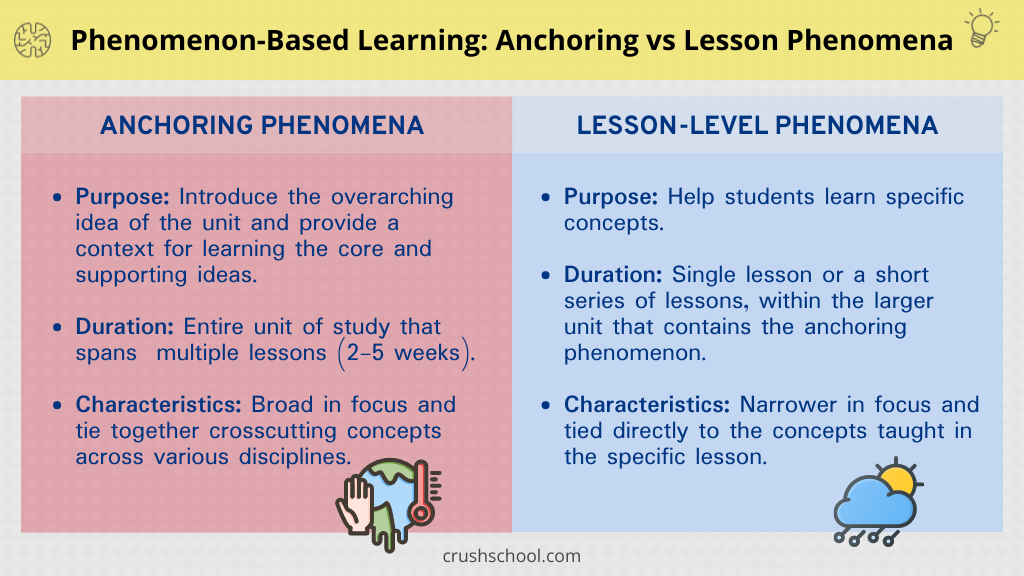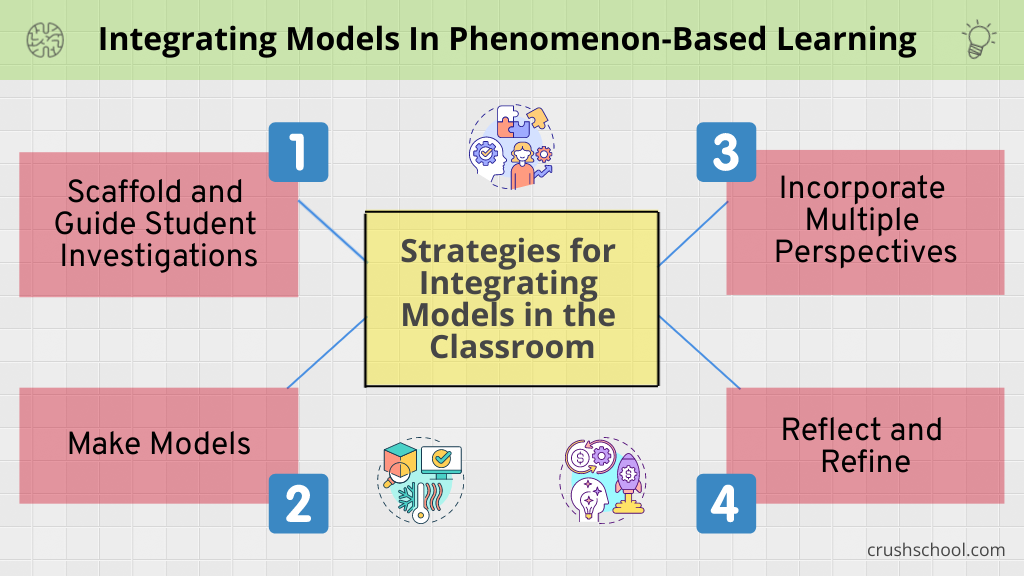Phenomenon-Based Learning: Lesson-Level vs Anchoring Phenomena
Using phenomena to engage students and drive learning is what Phenomenon-Based Learning (PhenBL) is all about.
First, identify the core idea along with its supporting ideas you want students to learn.
Second, choose a phenomenon that will lead students to discovering these ideas.
Third, give students the time and the tools to investigate. Initially, you might have to guide their investigations and help them break down phenomena.
Fourth, have your students examine and construct models that show and explain various concepts that describe and solve the phenomenon studied.
Fifth, find out what your students learned by using a thoughtful performance assessment (next post).
And don’t forget to involve peer and teacher collaboration, discussion, questioning, feedback, and common learning experiences to keep everybody on track while exploring phenomena.
Two types of phenomena
If you are fairly new to Phenomenon-Based Learning and the above steps make your head spin, you are not alone. PhenBL lesson design requires a lot of thoughtful planning and the first few months are the hardest, as is the case with starting, learning, and becoming good at every new thing life throws at us. But it gets easier, and once you get a full school year under your belt, you can mostly reuse and recycle from year to year and just tweak that which needs tweaking.
But your anchoring and lesson phenomena can stay the same. Unless better phenomena occur shortly before you are due to teach a related concept and you just do not want to (nor should you) pass up such easily-relatable opportunities.
Anchoring phenomena and lesson phenomena are both components of Phenomena-Based Learning, but they serve different roles in the instructional process.
Lesson Phenomena
Perhaps the fastest way to get comfortable with PhenBL is to choose and use lesson-level phenomena. This will allow you to repeat the lesson design cycle over and over in a short time span and lead to a level of comfort that helps you avoid the “how do I do this again?” brain pain.
Generally, lesson phenomena are used to drive single lessons that may last one or a few days. They are chosen to support the learning objectives of each lesson and require students to gain understanding of the concepts named by these objectives. While not too easy, lesson phenomena can be solved in a day or a few days.
Lesson-Level Phenomenon Example
Watching vinegar and baking soda react and form carbon dioxide is a good example of lesson-level phenomenon that might be used to introduce the concept of chemical reactions. As the vinegar (acetic acid) and the baking soda (sodium bicarbonate) react, students observe bubbles (carbon dioxide) forming. Teachers might have students measure the temperature before and after the reaction and write down the observations and questions these observations bring up. Then, students could use online resources (or the textbook) to answer the questions they generated.
Teachers can support students in their investigations by checking on the specifics each group is researching and asking leading questions that help students learn how to distinguish chemical reactions from physical changes or how to set up a simple experiment to test the identity of the produced gas. Then, students may be encouraged to repeat the original experiment utilizing their gas test - lighting a wooden splint and inserting it into the carbon dioxide enriched atmosphere.
This observable phenomenon serves as a concrete example to teach students about chemical reactions and can be “solved” in one or two days, depending on the scope of the lesson.
Anchoring Phenomena
Anchoring phenomena, or anchor phenomena, are used as starting points for entire units of study. They are carefully selected to engage students' curiosity and serve as a focal point for learning and inquiry throughout the unit. An anchoring phenomenon is much more difficult to solve and requires several weeks to be fully understood and explained by students. Each “anchor” is supported with multiple, related lesson-level phenomena and concepts these phenomena represent that help break down the anchor concepts into more digestible chunks.
Anchoring Phenomenon Example
Watching a series of images or a brief video about recent record temperatures, forest fires, droughts, floods, and other extreme weather events is a great way to introduce a unit on global climate and climate change or a unit that focuses on impacts of human activity on the Earth systems.
As any good anchor should send students down a rabbit hole of big and small ideas that support an overarching unit concept, this phenomenon, one that leads to the understanding the ins and outs of global climate change, should lead students to the investigation into global warming, greenhouse effect, heating of the oceans, shifting weather patterns, burning of fossil fuels, increased occurrence of extreme weather, and other human impacts and causes of climate change.
Such an anchoring phenomenon will take weeks and multiple, connected lessons to “solve” and will need to be supported with several lesson-level phenomena to focus students on deeply understanding one major global-climate-change-related concept at a time.
Anchoring vs Lesson Phenomena
In summary, anchoring phenomena are overarching real-world events that initiate an entire unit of study, providing a context for the exploration of concepts. They engage students and set the stage for deeper inquiry. On the other hand, lesson phenomena are specific examples or instances of observable events used within individual lessons to reinforce the concepts covered in that particular session. They support the learning objectives of each lesson and contribute to students' understanding of the broader core idea introduced by the anchoring phenomenon.
If you found this post helpful, sign up for my Teaching Tips, Resources, & Ideas Newsletter to get the next article on Creating Performance Assessments when it drops. It’s totally free.
BOOKS & TOOLS
- September 2025 2
- August 2025 5
- July 2025 4
- June 2025 2
- August 2024 2
- July 2024 2
- June 2024 1
- October 2023 1
- September 2023 3
- August 2023 6
- July 2023 6
- July 2022 2
- June 2022 1
- November 2020 3
- October 2020 3
- April 2020 1
- March 2020 5
- July 2019 1
- June 2019 1
- April 2019 1
- January 2019 1
- November 2018 3
- October 2018 2
- September 2018 1
- August 2018 8
- July 2018 11
- June 2018 4
- May 2018 5
- April 2018 2
- March 2018 4
- February 2018 5
- January 2018 3
- December 2017 1
- November 2017 5
- October 2017 7
- September 2017 6
- August 2017 5
- July 2017 3
- June 2017 10
- May 2017 7
- April 2017 7
- March 2017 15
- February 2017 12
- January 2017 13
- December 2016 15
- November 2016 8
- October 2016 7
- September 2016 12
- August 2016 14
- July 2016 10
- June 2016 13
- May 2016 10
- April 2016 8
- March 2016 5
- February 2016 7
- January 2016 6
- December 2015 5
- November 2015 8
- October 2015 2















